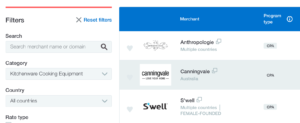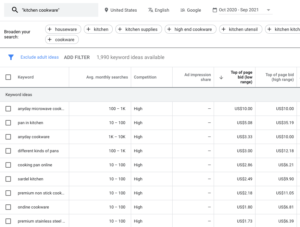I started blogging in 2014, and the art of growing my blog has been a rewarding experience I’ve (more often than not) loved. Many bloggers feel the same, and take great pride in the blogs they create. In reality, though, you probably aren’t going to pour a lot of time and effort into a blog month after month, year after year, if you’re spending money rather than making it.
Most bloggers, even part-time bloggers, hope to make some income from their blog. There’s a reason that searches about learning how to make money blogging are some of the top questions bloggers have. Blogging is hard work and should come with some monetary benefit.
Affiliate marketing is one of the most common and lucrative ways to monetize your blog, but picking the right affiliate niche can be difficult and confusing. How do you find affiliates? Which one will work best for your blog? How can you make sure you’ll actually make money?
In this guide, I’ll walk you through the basics of affiliate marketing, why it’s my number one choice for monetization, and how you can choose the right affiliate niche for you.
What Role Has Affiliate Marketing Played in My Own Blogging Success?
I believe in affiliate marketing because it has been successful for me and many of the people I have coached through the years.
Much of my blogging success can be traced back to strategically writing about topics I’m both personally interested in, and that have a clear connection to a potential product or service I can promote as an affiliate.
One very intentional example is my guide to starting a blog, in which I went out of my way to create (and maintain) an in-depth resource that genuinely leads my readers through the detailed process of getting their blogs off the ground, without taking on unnecessary work or expenses.
To this day, affiliate revenue from the articles across my site still represents about 75% or more of my blog’s income during an average month without another product launch, so it continues to be a substantial part of my business.
What is Affiliate Marketing?
Before we get into choosing your affiliate niche, I’ll give you a quick running definition of affiliate marketing.
In simple terms, affiliate marketing means finding businesses or products you enjoy (or believe in) and sharing them with your readers. If your readers purchase something from those businesses, you receive a predetermined sum of money.
Many affiliate programs give you a percentage of the sale, others give you a set price. For instance, many website hosting plans have a set sum they’ll pay you each time someone signs up for a hosting plan. This set price may increase with multiple sales — in which case you’d see a boost in profit when you reach five signups.
Now that you have a quick idea of what affiliate marketing is, I’ll help you navigate finding the right affiliate niche for you.
1. Consider Your Interests and Expertise
The number one step I always recommend is taking a look at your interests and expertise. What is your blog about and why are people visiting your blog? In what areas do your readers trust your expertise?
For instance, if you were a food blogger, you probably wouldn’t make a lot of headway trying to promote rock climbing equipment. You will, however, have a good chance of making money from high-quality cooking pots and utensils from merchants like these:

The items that you regularly use and love in your kitchen are the kinds of things that would make a perfect affiliate niche for your blog. You will be able to promote a product you believe in, and your readers will trust your recommendation because you’ve established yourself as an expert in your field.
2. Evaluate Profitability and Monetization
The next step is to evaluate how profitable your target affiliate niche is.
Will People Buy the Products In Your Affiliate Niche?
Using our example of the food blogger above, you would have to decide if the products you want to promote will convert to sales.
There’s a good chance the answer is yes. One benefit of being a food blogger is, everyone eats. Not everyone will buy expensive cooking items, but most people do cook at home at least a few nights a week. Even if you were to promote expensive and inexpensive kitchen items, if you translate these into a high number of sales, you’ll likely make a good profit.
On the other hand, if you only promote obscure kitchen items that very few people use or want, you won’t make very much money with that affiliate niche.
Here are some additional ways to know if there is a market for a product:
- Is it a good product? First and foremost when it comes to choosing profitable affiliate programs, you have to ask if the product is worth promoting. If it breaks easily or performs poorly it won’t generate a lot of sales. You also run the risk of losing future sales from promoting a bad product.
- Is your competition promoting it? If other people are promoting a product or service, there’s a high likelihood that there’s a market for it.
- Is the product selling well? You may not have access to this information for every affiliate, but many sellers will share how well their products are selling. Skimlinks has created a Trending products report that you can filter by “Most popular” to see which products are currently selling the most across their entire network.
- Test products. One of the best ways to see if there’s a market in your niche is to pitch things to your audience. Promote products you believe in and see how your audience responds to them. Does it convert to sales, or do people largely ignore the posts you share about them?
Does the Affiliate Pay Well?
You also have to consider how well the affiliate program pays. Some programs pay very little for each sale, which means you would have to convert a TON of readers in order to produce a reasonable profit.
Even if you have a high-traffic website, an affiliate program that pays poorly will not lead to high profits and will ultimately be a frustrating experience.
To help avoid working with low-paying affiliates, you can use something called Earnings Per Click (EPC). Skimlinks provides the EPC for every merchant so publishers can quickly deduce if they’re worth their time.
3. Research the Competition (Yours and Competing Affiliate Programs)
Once you’ve found some products or services you’re interested in promoting, it’s time to do a little digging into the competition. This means checking out your competition as well as the affiliate program’s competition.
Investigate the Affiliate Program’s Competition
On my blog, I’ve chosen to work with two primary hosting companies I use and believe in: Bluehost and Dreamhost.
When I was deciding which affiliate programs to use, I had to research if Bluehost and Dreamhost were worth my time. Were they programs my readers would like and are these hosting plans popular enough to compete against other hosting plans?
Bluehost and Dreamhost have shown themselves to stand up against the competition, and are quality products with great reviews. People consistently prefer these companies and are happy with their performance. This showed me it was a good product to promote on my site and one that will lead to easier conversions.
Research Your Competition
If you know the product you want to promote does well against its competition, the next step is to research what kind of competition you will have in this affiliate niche.
How many bloggers are already promoting the service or product you want to partner with?
In my case, there are a lot of people promoting hosting plans. I had to decide if my blog was receiving enough traffic and interest to keep up with the many other blogs that were promoting hosting affiliate programs, and if not, what I needed to do to elevate my blog to that level.
For new bloggers, I would recommend finding an affiliate niche that has relatively low competition so you have a chance of converting sales. This could also be called “searching for market gaps” which I’ll talk about in the point below.
4. Search for Market Gaps in Affiliate Niches
When you’re thinking of the right affiliate niche for your blog, a good place to start is the market gaps.
A market gap is something people want that isn’t being provided. As an example, at the beginning of the pandemic, there was a market gap for face masks. Lots of people wanted to purchase masks, but there weren’t many businesses providing them on a mass level.
In terms of affiliate marketing and blogging, the market gap would be a lack of reviews for products or services that people are really interested in. Readers rely on bloggers to provide real, in-depth reviews so they know if it’s something they can trust. They want to know if the product they want is worth the money they’re going to spend.
How can you find market gaps? Here are a few tips:
- Keep up with the trends. New products or things that have recently become popular will not have as many reviews or affiliate partners. This is a good time to create content that promotes these items.
- Talk to people. Talk to people interested in your blogging niche. What do they want? What do they say isn’t being provided for right now?
- Spend some time searching on Google. What are some products you love and want to promote? Head over to Google and see what kind of content already exists on those items.
- Check out social media. What are people talking about on TikTok, Reddit, Quora, Facebook, Twitter, and Instagram? If you want to get to the heartbeat of things, people will let you know on social media.
- Think of unique problems you can solve. What are some problems you know exist in your niche? How can your potential affiliate partner solve those problems in a new way?
5. Choose Low-to-Medium Competition Keywords With High Purchase Intent
When you’re promoting products or services on your blog you also have to factor in Google. That means minding search engine optimization or SEO.
Three questions to ask yourself are:
- Are people searching for it?
- Are people interested in buying it (high purchase intent)?
- Is the keyword competition fairly low (are you able to rank high in a Google search for this keyword)?
Keywords or keyword phrases are used to signal to Google what your content is about. You’ll often repeat keywords several times throughout your content, especially in titles and headlines.
As an affiliate partner, you won’t just be writing a standard review of the product or service you’re promoting. Yes, you should write a standard review, but that isn’t the only piece of content you can use to promote it. For example, I’ve promoted hosting plans in a number of my blog posts including articles like:
These are all keyword phrases that people search for frequently on Google, and they naturally lend me the opportunity to promote my affiliate partners.
When you choose your keyword phrases, don’t worry if there isn’t a high search volume. You want to choose something people do search for, but it doesn’t have to have millions of searches a month to make it worth your time. As long as you have a reasonable chance at ranking well for them and they lead to conversions for an affiliate product you can promote.
Over time, I’ve scaled up the number of affiliate programs I’m promoting and continue to find new content topics that have low-to-medium competition and somewhat high purchase intent so that I’m maximizing my opportunities at boosting my affiliate marketing revenue.
Use Google Keyword Planner
Google keyword planner is a handy tool for looking up keywords and keyword phrases. It can tell you how many people are searching for a given keyword and if it has low or high competition. You can also take notice of the section that says “suggested bid.” The suggested bid gives you an idea of how much marketers might be willing to pay per click.
Google describes the “suggested bid” section like this: “The tool’s suggested bid column shows the average amount being spent to rank in a top-level position for a particular keyword.”
In other words, people wouldn’t pay to rank for these positions if they weren’t profitable.
Here’s an example of a search using “kitchen cookware” in Google keyword planner.

I changed the page bid section to show me the highest bids first. You can look through the suggestions and see if any of these would work for items you would like to promote on your blog.
You can also search for a combination of low-competition keywords that still have bids listed. For example, baking pots have a high search volume, low competition, and .15-.73 cent bids.

Understand the Buyer’s Journey
When it comes to marketing products, it’s beneficial to understand something called “the buyer’s journey.”
When someone first starts thinking about a product they want to purchase, it usually begins with a need. Using our example of a food blogger, a potential consumer may begin their buyer’s journey when they want to make soup and realize they don’t have a big enough pot. This is often called the awareness stage, as they become aware of an issue that requires a solution.
Next, a person will begin considering their options (also known as the consideration stage). Should they try to make soup with a smaller pot, or do they really need to purchase a bigger one?
The next step is the decision stage. That’s where they know they want to buy something, but they aren’t sure which product is the best choice. The smaller pot doesn’t work well for their soup, but they don’t know which stockpot they want to purchase.
You can create content for every part of the buyer’s journey, but the one that has the highest purchase intent is the decision stage. For this stage, you can create content like “Best Stock Pots for Making Soup” or “Best Large Kitchen Pots in 2021” or “Why I Use (Insert Affiliate Product) in My Kitchen.”
6. Don’t Neglect the Potential of Video
Videos and YouTube are a natural fit for bloggers today. People love videos and they can be a great complement to your blog and your affiliate niche.
Doing things like video product reviews or service reviews where you talk through your experience of a tool, product, or service you can promote as an affiliate, is a great way to (1) find new audiences on platforms like YouTube and (2) engage your readers in a way other than just written content.
In addition to my ultimate guide on starting a blog, I’ve also created an in-depth YouTube video that breaks down the ideas into video form. This helps me connect to new audiences, engage my readers that prefer visual/video content, and it helps with my SEO as blog posts with videos tend to rank a bit higher on a Google search.
Some of my Top Picks for Affiliate Programs
I already spoke about Bluehost and Dreamhost as excellent affiliate partners if you’re in the web hosting industry, but some other affiliate programs I highly recommend—many of which are accessible through Skimlinks) include:
- Chewy. This wildly popular online mega-store for everything pet-related will also reward you handsomely for referring customers their way.
- Nike. The global clothing, shoe, and apparel brand that’s made its way into just about every corner of the planet.
- Madewell and Everlane. These two fast-growing US-based clothing brands make a good affiliate partner for fashion-oriented blogs.
- ConvertKit. ConvertKit is an email marketing provider that has an affiliate program. A bonus is, you don’t have to meet a minimum threshold in order to get paid.
- Skillshare. Skillshare is a US-based online learning community that offers educational courses in an abundance of fields.
For more affiliate program ideas, check out the extensive list of merchants on Skimlinks, curated specifically for bloggers.
Final Thoughts: Choosing the Right Affiliate Niche For You
Affiliate marketing has been a huge benefit to my blog through the years, and I believe it can be for yours as well.
A couple of things to consider as you try to choose an affiliate partner:
- Choose more than one affiliate program. If your blog lends itself to more than one type of product, having multiple affiliates opens your blog to opportunities and can diversify your income if one isn’t performing as well as another.
- Drop any affiliate partner that doesn’t work for you. If you’re not making sales from an affiliate program, change things up and pick something new. You can always reevaluate if something isn’t working.
My best advice is to choose an affiliate niche you trust and start creating content based on keywords and keyword phrases your readers might be searching for. There’s no better way to find out what works than to test it out for yourself.


